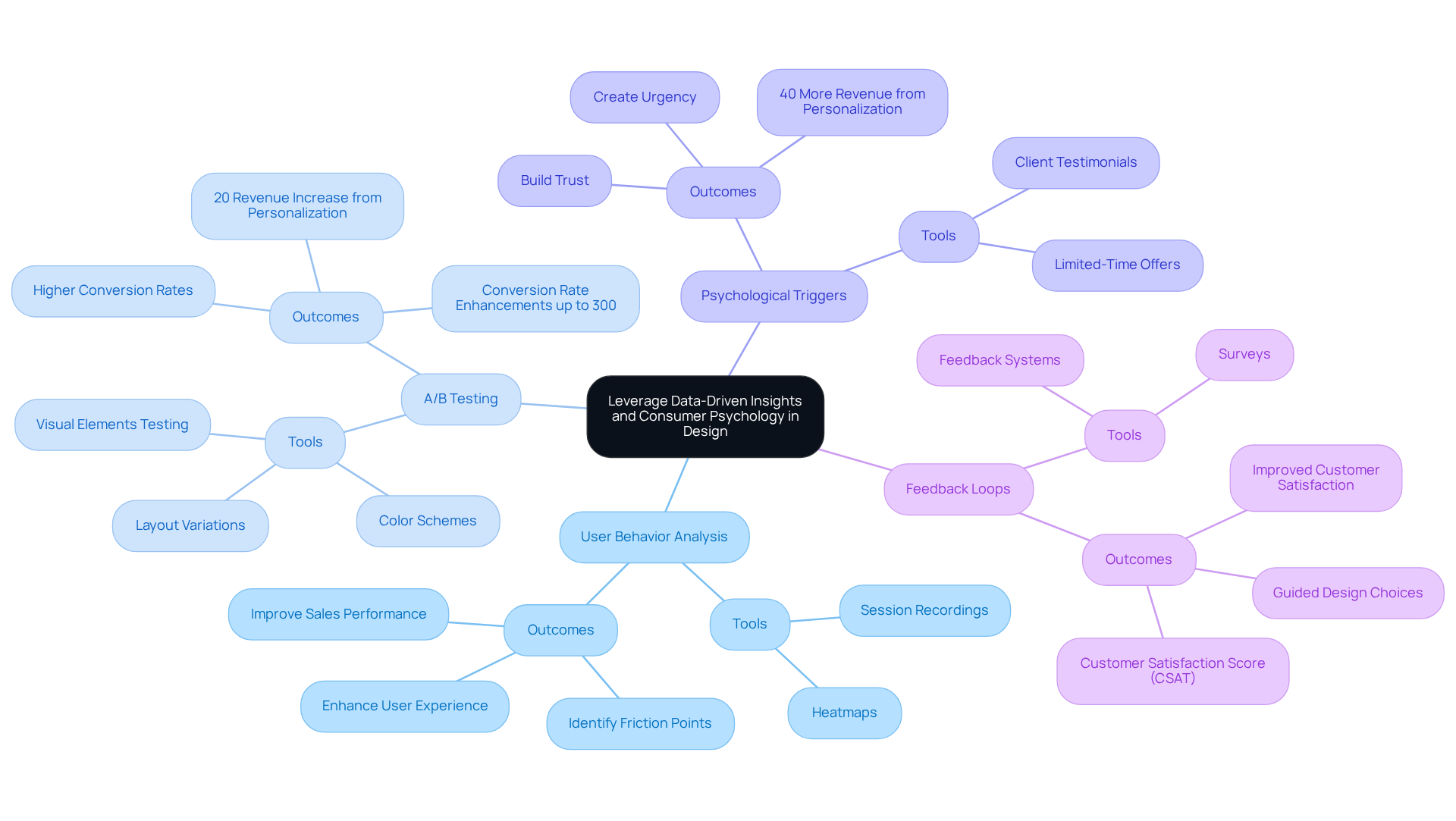
Overview
To achieve success in e-commerce website design, four key practices stand out:
- Understanding core principles such as clarity and responsiveness
- Implementing best practices for user experience and conversion optimization
- Leveraging data-driven insights alongside consumer psychology
- Adopting a strategy of continuous testing and iteration for sustained growth
These practices are not merely suggestions; they are essential components that enhance customer engagement, build trust, and ultimately drive increased conversion rates and customer loyalty. By effectively addressing both user needs and market trends, businesses can position themselves for long-term success in the competitive e-commerce landscape.
Introduction
Crafting a successful e-commerce website is a formidable challenge; it demands a profound understanding of design principles that prioritize user experience and conversion rates. By delving into essential practices such as:
- responsive layouts
- streamlined checkouts
- data-driven insights
brands can significantly enhance their online presence and customer satisfaction. Yet, the pressing question persists: how can businesses continuously adapt and innovate in an ever-evolving digital landscape to not only attract but also retain customers?
Understand Core Principles of E-Commerce Website Design
To establish an effective e commerce website designing, understanding the fundamental concepts of layout that emphasize customer experience is essential. Clarity is paramount; the website's purpose and offerings must be immediately clear to visitors. Research indicates that it takes just 50 milliseconds for visitors to decide whether to stay on an eCommerce site. Therefore, utilizing clear navigation and concise messaging is crucial for assisting individuals effortlessly.
Responsiveness is another critical element. Designing for various devices ensures that the website functions seamlessly on desktops, tablets, and smartphones. A responsive layout not only improves accessibility but also enhances user satisfaction. Given that the average American spends over five hours daily on mobile devices, mobile optimization is no longer optional.
Visual hierarchy plays a significant role in guiding user attention. By utilizing size, color, and placement effectively, important elements such as calls to action (CTAs) and product features can be highlighted. Compelling product descriptions and clear CTAs are essential in e commerce website designing, as they can improve conversion rates by up to 40%, underscoring the importance of engaging visuals.
Incorporating trust signals is vital for building consumer confidence. Elements such as client reviews, security badges, and clear return policies can significantly influence purchasing decisions. As Michael Keenan aptly states, "Trust from clients is most difficult to gain when you lack any clients, so you’ll want to include the following trust indicators as you develop your website." When consumers feel , they are more likely to complete transactions.
By adhering to these principles, brands can establish a robust foundation for e commerce website designing, ultimately leading to increased conversion rates and client loyalty. Moreover, avoiding common pitfalls in e-commerce design, such as neglecting mobile visitors or creating confusing navigation, is essential for maintaining efficiency and attracting prospective customers.

Implement Best Practices for User Experience and Conversion Optimization
To optimize user experience and conversion rates, brands must adopt that enhance engagement and efficiency.
- Streamlined Checkout Process: A simplified checkout process is crucial. Minimize the number of steps required to complete a purchase. Implement guest checkout options and clearly display progress indicators to enhance user satisfaction.
- High-Quality Visuals: High-resolution images and videos are non-negotiable. They allow customers to zoom in and examine products from various perspectives, significantly improving the shopping experience.
- Clear CTAs: Prominent and compelling calls to action are essential. Design buttons that direct customers toward desired actions, such as 'Add to Cart' or 'Buy Now,' using contrasting colors to ensure they stand out.
- Personalization: Leverage individual data to provide tailored recommendations and experiences. Personalized content can significantly boost engagement and conversion rates.
By implementing these best practices in e commerce website designing, brands can create a more engaging and efficient shopping experience, ultimately resulting in increased sales and heightened customer satisfaction.

Leverage Data-Driven Insights and Consumer Psychology in Design
To effectively leverage data-driven insights and consumer psychology in e-commerce design, consider the following strategies:
- User Behavior Analysis: Employ tools such as heatmaps and session recordings to gain a comprehensive understanding of user interactions on your site. This analysis helps identify friction points, enabling targeted optimizations that enhance the user experience. E-commerce businesses that utilize data science for customer behavior analysis often see significant improvements in sales performance.
- A/B Testing: Regularly perform A/B tests on various visual elements, including calls-to-action (CTAs), layouts, and color schemes. This iterative process allows you to determine which variations resonate best with your audience, leading to higher conversion rates. Effective A/B testing can result in conversion rate enhancements of up to 300%, and businesses concentrating on personalized marketing realize a 20% rise in revenues, showcasing its efficacy in honing strategy approaches.
- Psychological Triggers: Incorporate psychological principles into your creation, such as scarcity through limited-time offers and social validation via client testimonials. These elements can significantly influence purchasing behavior, as they create a sense of urgency and trust among potential buyers. Companies excelling in personalization, which often includes these psychological triggers, generate 40% more revenue from these activities than average performers.
- Feedback Loops: Implement surveys and feedback systems to gather insights directly from clients. This information is invaluable for guiding design choices and improving customer satisfaction. By understanding customer preferences and pain points, brands can create tailored experiences that drive conversions. Assessing the effectiveness of these feedback loops can be achieved using the Customer Satisfaction Score (CSAT), offering a concrete metric for evaluating client satisfaction.
By incorporating these data-informed approaches and psychological understandings, brands can enhance their e-commerce website designing to create more efficient online layouts that meet consumer needs and significantly improve conversion rates.

Adopt Continuous Testing and Iteration for Sustained Growth
To ensure sustained growth and optimization of your e-commerce website, implement the following practices:
- Regular Performance Reviews: Schedule periodic reviews of website performance metrics, including conversion rates, bounce rates, and average order values. Utilize this data to . High-performing organizations recover from incidents 6,570 times faster than low performers, underscoring the importance of these reviews in maintaining a competitive edge.
- Iterative Development Process: Embrace an iterative approach to creation, where modifications are made based on testing outcomes and participant feedback. This strategy allows for ongoing refinement and enhancement of the user experience. As Carina McLeod from the eCommerce Nurse podcast states, "Data is the cornerstone of a successful testing strategy," emphasizing the necessity of a data-driven approach.
- Stay updated on trends that can impact e-commerce website designing by keeping abreast of industry trends and emerging technologies. Adapting to these changes can provide a distinct competitive advantage. Brands that fail to innovate risk falling behind in a rapidly evolving market.
- Engage with Users: Foster a community around your brand by interacting with clients through social media and email. Their insights can guide your testing and iteration efforts. Parah Group's clients have experienced a 36% increase in ROI on ads by effectively leveraging customer feedback.
By adopting a mindset of ongoing testing and iteration, brands can ensure their e-commerce website designing remains effective and aligned with customer expectations, ultimately fostering long-term growth. Additionally, be vigilant of common pitfalls such as neglecting user feedback or failing to adapt to new trends, as these can significantly hinder your optimization efforts.

Conclusion
Understanding the key practices of e-commerce website design is essential for creating a successful online shopping experience. By focusing on core principles such as clarity, responsiveness, visual hierarchy, and trust signals, brands can significantly enhance user engagement and conversion rates. These foundational elements not only improve customer satisfaction but also foster loyalty, ultimately driving sales growth.
The article highlights several crucial strategies that contribute to effective e-commerce design:
- Streamlining the checkout process
- Utilizing high-quality visuals
- Implementing clear calls to action
- Personalizing user experiences
These are all vital practices that can lead to a more efficient and enjoyable shopping journey. Additionally, leveraging data-driven insights and consumer psychology allows brands to fine-tune their designs, ensuring they meet the evolving needs of their customers.
In conclusion, the significance of continuous testing and iteration cannot be overstated. By regularly assessing performance metrics and adapting to industry trends, businesses can maintain a competitive edge in the ever-changing e-commerce landscape. Embracing these practices not only enhances user experience but also positions brands for sustained growth and success in the digital marketplace. Prioritizing these strategies will ultimately create a more engaging, trustworthy, and efficient shopping environment that resonates with consumers.
Frequently Asked Questions
What are the core principles of e-commerce website design?
The core principles include clarity, responsiveness, visual hierarchy, and incorporating trust signals. These elements emphasize customer experience and help improve conversion rates.
Why is clarity important in e-commerce website design?
Clarity is crucial because visitors need to understand the website's purpose and offerings immediately. Research shows that it takes just 50 milliseconds for visitors to decide whether to stay on a site.
What does responsiveness mean in the context of e-commerce websites?
Responsiveness refers to designing the website to function seamlessly across various devices, including desktops, tablets, and smartphones. It enhances accessibility and user satisfaction.
How does visual hierarchy affect user experience on e-commerce websites?
Visual hierarchy guides user attention by effectively using size, color, and placement to highlight important elements like calls to action (CTAs) and product features, improving engagement and conversion rates.
What role do trust signals play in e-commerce website design?
Trust signals, such as client reviews, security badges, and clear return policies, are vital for building consumer confidence and influencing purchasing decisions.
How can compelling product descriptions and clear CTAs impact conversion rates?
Compelling product descriptions and clear CTAs can improve conversion rates by up to 40%, making them essential components of effective e-commerce website design.
What common pitfalls should be avoided in e-commerce design?
Common pitfalls include neglecting mobile visitors and creating confusing navigation, both of which can hinder efficiency and deter prospective customers.
FAQs











